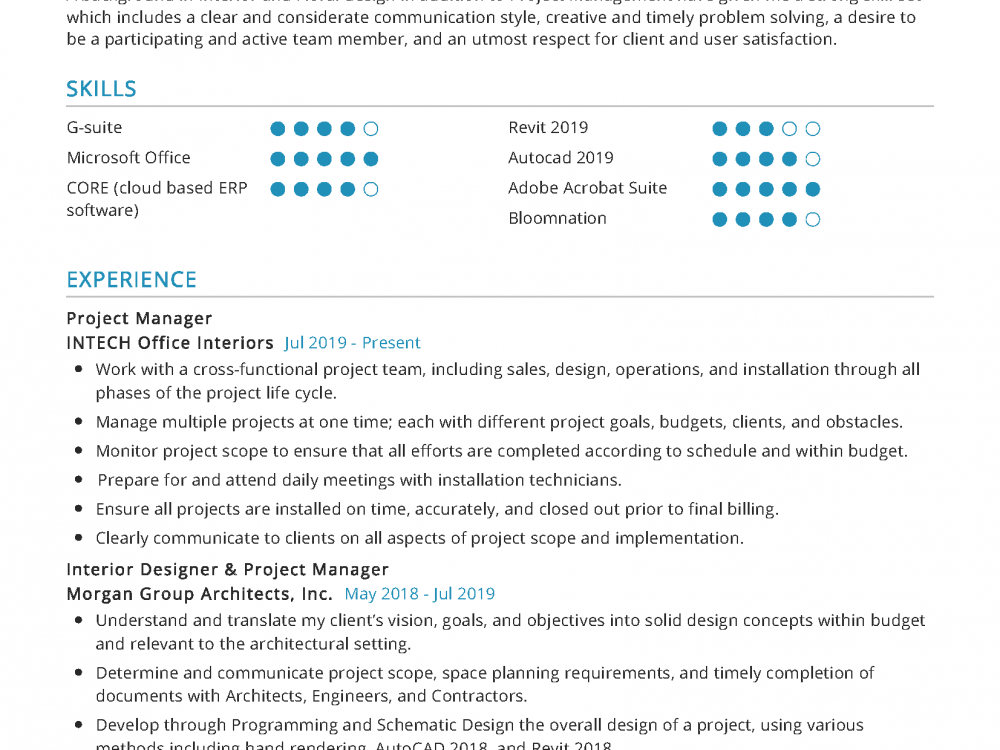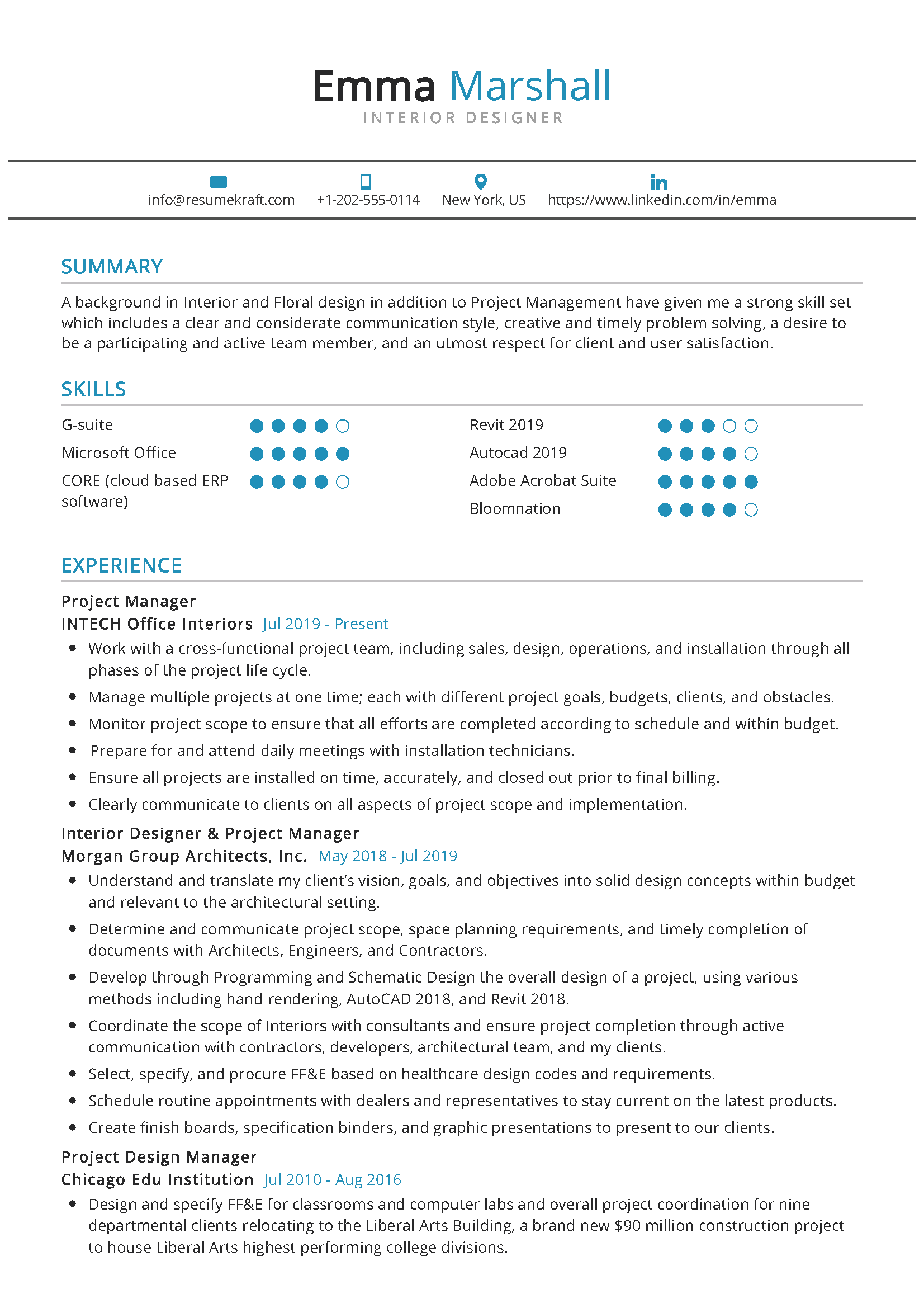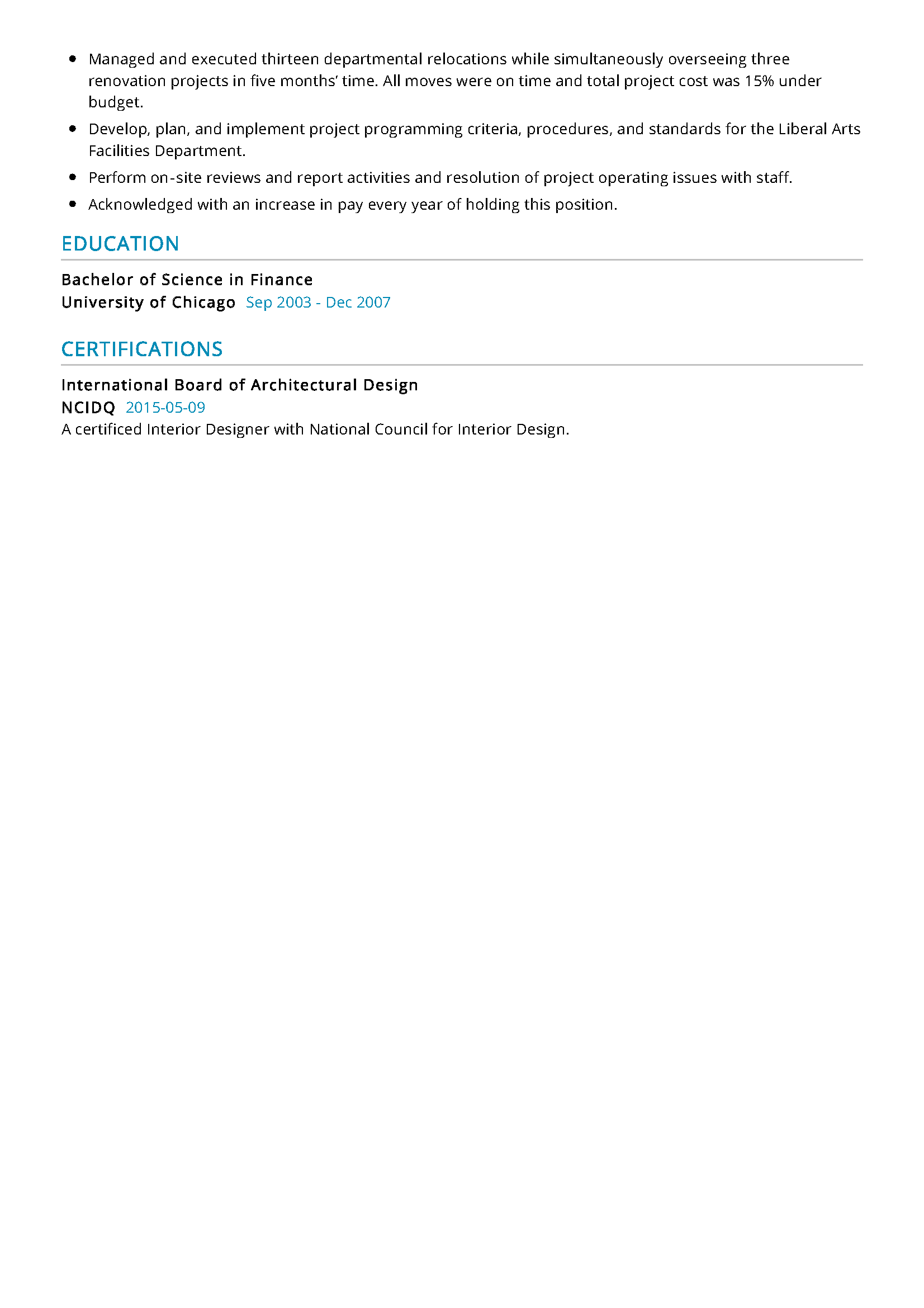Are you an Interior Designer by profession and looking for an exciting career? We have good news for you! use our professional Interior Designer Resume Sample. You don’t have to start writing from scratch. Just click “Edit Resume” and modify it with your details. Update the template fonts and colors have the best chance of landing your dream job. Find more resume samples.
Interior Designer Resume Example
Emma Marshall
Interior Designer
Summary
A background in Interior and Floral design in addition to Project Management have given me a strong skill set which includes a clear and considerate communication style, creative and timely problem solving, a desire to be a participating and active team member, and utmost respect for client and user satisfaction.
Experience
- G-suite
- Microsoft Office
- CORE (cloud-based ERP software)
- Revit 2019
- Autocad 2019
- Adobe Acrobat Suite
- BloomNation
Experience
Project Manager
INTECH Office Interiors
- Work with a cross-functional project team, including sales, design, operations, and installation through all phases of the project life cycle.
- Manage multiple projects at one time; each with different project goals, budgets, clients, and obstacles.
- Monitor project scope to ensure that all efforts are completed according to schedule and within budget.
- Prepare for and attend daily meetings with installation technicians.
- Ensure all projects are installed on time, accurately, and closed out prior to final billing.
- Clearly communicate to clients on all aspects of project scope and implementation.
Interior Designer & Project Manager
Morgan Group Architects, Inc.
- Understand and translate my client’s vision, goals, and objectives into solid design concepts within budget and relevant to the architectural setting.
- Determine and communicate project scope, space planning requirements, and timely completion of documents with Architects, Engineers, and Contractors.
- Develop through Programming and Schematic Design the overall design of a project, using various methods including hand rendering, AutoCAD 2018, and Revit 2018.
- Coordinate the scope of Interiors with consultants and ensure project completion through active communication with contractors, developers, architectural team, and my clients.
- Select, specify, and procure FF&E based on healthcare design codes and requirements.
- Schedule routine appointments with dealers and representatives to stay current on the latest products.
- Create finish boards, specification binders, and graphic presentations to present to our clients.
Project Design Manager
Chicago Edu Institution
- Design and specify FF&E for classrooms and computer labs and overall project coordination for nine departmental clients relocating to the Liberal Arts Building, a brand new $90 million construction project to house Liberal Arts highest performing college divisions.
- Managed and executed thirteen departmental relocations while simultaneously overseeing three renovation projects in five months’ time. All moves were on time and the total project cost was 15% under budget.
- Develop, plan, and implement project programming criteria, procedures, and standards for the Liberal Arts Facilities Department.
- Perform on‐site reviews and report activities and resolution of project operating issues with staff.
- Acknowledged with an increase in pay every year of holding this position.
Education
Bachelor of Science in Finance
University of Chicago
Certifications
International Board of Architectural Design
NCIDQ
Career Expert Tips:
- Always make sure you choose the perfect resume format to suit your professional experience.
- Ensure that you know how to write a resume in a way that highlights your competencies.
- Check the expert curated popular good CV and resume examples
Interior Designer Resume with Writing Guide
This post will focus on writing a resume for an aspiring Interior Designer. It will discuss how to customize your resume for this particular profession and provide resources that can be easily found online. With this guide, you’ll know what to put in, what to take out, and how to make it professional with novices in mind.
Decide whether or not you will include a cover letter with your resume. Some people have the option of including one while others must attach them as an attachment when submitting their documents electronically.
Interior Designer Resume Writing Guide:
1. Career Summary
This section is the main part of your resume where you will want to put your high level accomplishments and skills. In this section, employers that are checking through hundreds of resumes will see what you have done with your past experiences. This is where they can get a sense of what it is that you bring to their organization, so make sure to emphasize some very important points here. You also want to create some hype for yourself by using eye-catching language in this section.
For an Interior Designer, you want to highlight work that has been both challenging and engaging. A good job in the past that you really enjoyed is also a great way to convey that from your resume. Presenting yourself as having a passion for your work will help others get and impression of who you are and what values you have at your job. This will help create a good impression on your employer.
2. Education
This is where you will want to highlight the most important topics you learned in school and during your educational experience. Some of the classes that might be helpful for an Interior Designer include color theory, furniture design, interior material characteristics, and architectural concepts. In this section you can also put in any clubs or activities that may relate to your work as an interior designer (i.e a club dedicated to interior design). A good degree will be something like a B.A. or B.S in Interior Design which is normally acquired from a four year university.
3. Job Experience
This section is the most important one to flesh out and discuss at length because it shows employers what you have actually done in your past jobs and how that can translate to their organization’s needs. This section should be fairly long. You don’t want to make it so long that it doesn’t make sense and you don’t want to leave anything out. You should start with your first job and then move into some of your more recent positions in order to keep the narrative flowing.
4. Skills & Abilities
This section is where you’ll list all of the areas in which you have worked with/developed or have knowledge that can be used throughout an Interior Design career. Here is where you can mention any participation in volunteer work, extracurriculars, school clubs, and outside education that might be helpful to your current work as an Interior Designer. This section should cover some of the basic skills (i.e. computer proficiency) as well as some less common skills and abilities that a Interior Designer might need (i.e. knowledge of certain building codes).
5. References
Lastly, you will want to include a list of references who might help you in your job as an Interior Designer. This is the first step in getting those screening interviews if you need them. While being asked for a reference is not how you will land a job, it does help a lot with the interview process and finding out more about your skills. If nothing else, there will be some information that goes into your application that might make an employer more likely to call for an interview.
Interior Designer Responsibilities:
- To provide creative solutions for interior design and decoration services.
- To ensure that all design work is carried out professionally, efficiently, and on schedule with good quality workmanship.
- To create innovative designs using innovative and safe materials provided by the company.
- To implement environmentally friendly practices in the planning, production and installation processes so as to minimize or eliminate waste of material, energy & water use, and reduce environmental impact.
- To create paperwork and documents for all interior design related activities.
- To ensure that all details are taken care of, to the extent that they are within your control.
- To make sure that delegated tasks are carried out if you are supervising any subordinates in your team or department.
- To be able to give instructions and directions to others in the firm, if they fall under your department or business unit, i.e. supervisors, key staff and superintendents.
- To provide customer services to clients and customers in accordance with standard practices of your company.
- To make sure that all work is done as it is being scheduled, it being quality work and required documents being prepared carefully.
Top 15 Must-have Interior Designer Skills:
- Communication skills.
- Attention to detail (Organized)
- Creative thinking.
- Interpersonal skills, i.e., being able to communicate and interact with all types of people, both naturally and under the pressure of time and stress.
- Good decision-making skills, i.e. to make decisions both quickly and responsibly.
- Innovation and Creativity skills, i.e., to come up with original ideas to help solve problems as they arise.
- Problem-solving skills, i.e., the ability to problem-solve under the pressure of time and stress, be creative and innovative, accept a challenge.
- Teamwork skills, i.e., being able to work well with others as part of a team or group in order to achieve common goals or tasks as a team member or leader.
- Time management skills, i.e., to make sure everything is done on time, being organized in planning and executing of work tasks and processes to reach required goals.
- Workload management skills, i.e., to manage workload effectively, work efficiently, and have a positive working attitude toward work-related stress and challenges as they arise.
- Communication skills, i.e., written and verbal communication without losing or misinterpreting information being communicated as well as expressing yourself clearly with grammar conventions (i.e. spelling and punctuation) so as to ensure clear communication.
- Attention to detail, i.e., being able to spot errors and discrepancies in work or documents as well as paying close attention to detail as tasks being completed and providing accurate information.
- Creative thinking, i.e., being able to think outside the box and come up with innovative solutions that fix problems or issues in a creative manner rather than a traditional one.
- Interpersonal skills, i.e. communicating and interacting with clients, co-workers, supervisors and supervisors.
- Problem-solving skills, i.e., to find solutions to problems in a timely manner utilizing effective problem solving methods and strategies.
Interior Designer Resume Objective:
The resume objective should highlight the fact that you are an Interior Designer with a high degree of experience in the relevant field. Just like a cover letter, you should highlight the fact that you meet the qualifications for the job advertised. Here are some examples of the exercises you can use to create your resume objective.
- Interior Designer Objective: “I am an Interior Designer with six years of experience in the field, and have successfully completed projects that range from high end residential to industrial buildings and retail spaces.”
- Interior Designer Objective: “I am an Interior Designer with fifteen years of experience in the field, and have successfully completed projects that ranged from high end residential to commercial office spaces.”
- Interior Designer Objective: “I am an Interior Designer with experience in a variety of projects as well as the ability to take a project from the conceptual stage through to completion.”
- Interior Designer Objective: “I have successfully completed projects that ranged from high end residential to retail commercial office spaces with great attention and dedication.”
- Interior Designer Objective: “I am an experienced interior designer who is an expert in interior design and can easily work with clients to help accomplish their design goals.”
Tips:
- Keep your resume objective job-specific and to the point.
- Include a summary of your work experience so far as well as the skills and abilities that you bring to the table.
- Finish with a strong sentence that emphasizes why you are a good candidate for the job. The resume should be concise and clear, with all the information on it in a way that is easy to read.
- The objective section should fit into one page, not two pages.
- Describe your skills in a way that highlights their value to the employer. Don’t be too vague or wordy, as this is a resume, not a book report!
- Avoid using big words as they are confusing and will only alienate you from the employer if they can’t understand you.
Interior Designer Cover Letter:
The resume objective should be placed at the top of the resume, as that is the first thing an employer will see when they open your resume. It should follow your name and contact information. The cover letter should be placed underneath on a separate page or separate document, and it should not be included in the actual resume as it contains extra information that may not be relevant to the employer.
Tips:
- The cover letter should be quick, concise, and succinct.
- Avoid using blatant sales techniques such as “please call me for more information”, “I have been a loyal customer for many years”, or “If you are interested in my services, I would like to earn your business”.
- Keep it short and sweet.
- Make sure the letter is direct and to the point.
- Type or print out the letter on good quality white paper with black ink as it will make it look professional and can stand out from other resumes.
Key Takeaways:
- Always put your resume into the body of an email and attach it as a Word document.
- Be aware of the different types of resumes.
- Make sure your resume is relevant and up to date.
- Make sure you highlight your skills, abilities, accomplishments and achievements.
- Use a resume objective that is specific and to the point.
- Use action verbs in your resume and keep it concise and clear.
- Make sure the cover letter is short, direct and to the point, with basic information only.
- The cover letter can also be found printed within the body of an email when you place your resume into a Word document.



